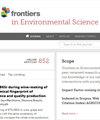部分连通的污水处理厂对用作灌溉水源的雨水渠水质的影响
IF 3.3
3区 环境科学与生态学
Q2 ENVIRONMENTAL SCIENCES
引用次数: 0
摘要
库鲁内加拉市的城市雨水渠收集径流和未经处理的废水,导致公共卫生问题。大库鲁内加拉污水处理厂(GKSTP)于 2018 年投入使用,目前以 73% 的处理能力运行,以应对公共卫生问题。本研究对运河水质进行了评估,并将其与标准和大库伦内加拉污水处理厂投入使用前的状况进行了比较。研究人员在旱季和雨季从七个地点采集了水样,并测量了理化参数。使用一般线性模型 (GLM) 对数据进行了空间和时间分析。此外,还采用了聚类分析和基于距离的冗余分析。水质指数 (WQI) 被用来评估污水处理厂的有效性。研究显示,运河沿岸的理化参数存在明显的时空变化(p & lt; 0.05,GLM),潮湿月份的污染程度较高。水质指数从 35(2005 年)提高到目前的 49,表明水质有所改善(p< 0.05,方差分析),但仍不能令人满意。这项研究对传统废水处理方法的局限性提出了新的见解,表明仅仅处理废水并将其排放回运河是不够的。研究强调了重新思考废水处理后再利用对实现多个可持续发展目标(SDGs)的重要性。这种方法为加强全球水安全和环境可持续性提供了一条务实的前进道路。本文章由计算机程序翻译,如有差异,请以英文原文为准。
Impacts of a partially connected wastewater treatment plant on the water quality of stormwater drains used as an irrigation source
Urban stormwater drains in Kurunegala City collect runoff and untreated wastewater, leading to public health problems. The Greater Kurunegala Sewage Treatment Plant (GKSTP) was commissioned in 2018 and currently operates at 73% of its capacity to combat public health issues. This study assessed the water quality of canals, comparing it with standards and pre-GKSTP conditions. Water samples were collected from seven sites during dry and wet seasons, and physicochemical parameters were measured. The data underwent spatial and temporal analysis using the general linear model (GLM). Additionally, cluster analysis and distance-based redundancy analysis were employed. The water quality index (WQI) was employed to evaluate the effectiveness of the treatment plant. The study revealed significant spatial and temporal variations in physicochemical parameters along the canals (p < 0.05, GLM), with higher pollution levels during wet months. The WQI improved from 35 (2005) to 49 at present, indicating enhanced water quality (p < 0.05, ANOVA), although it remains unsatisfactory. This study provides novel insights into the limitations of conventional wastewater treatment practices, demonstrating that merely treating wastewater and discharging it back into canals is insufficient. Research underscores the importance of rethinking treated wastewater reuse in achieving multiple sustainable development goals (SDGs). This approach offers a pragmatic path forward for enhancing water security and environmental sustainability globally.
求助全文
通过发布文献求助,成功后即可免费获取论文全文。
去求助
来源期刊

Frontiers in Environmental Science
Environmental Science-General Environmental Science
CiteScore
4.50
自引率
8.70%
发文量
2276
审稿时长
12 weeks
期刊介绍:
Our natural world is experiencing a state of rapid change unprecedented in the presence of humans. The changes affect virtually all physical, chemical and biological systems on Earth. The interaction of these systems leads to tipping points, feedbacks and amplification of effects. In virtually all cases, the causes of environmental change can be traced to human activity through either direct interventions as a consequence of pollution, or through global warming from greenhouse case emissions. Well-formulated and internationally-relevant policies to mitigate the change, or adapt to the consequences, that will ensure our ability to thrive in the coming decades are badly needed. Without proper understanding of the processes involved, and deep understanding of the likely impacts of bad decisions or inaction, the security of food, water and energy is a risk. Left unchecked shortages of these basic commodities will lead to migration, global geopolitical tension and conflict. This represents the major challenge of our time. We are the first generation to appreciate the problem and we will be judged in future by our ability to determine and take the action necessary. Appropriate knowledge of the condition of our natural world, appreciation of the changes occurring, and predictions of how the future will develop are requisite to the definition and implementation of solutions.
Frontiers in Environmental Science publishes research at the cutting edge of knowledge of our natural world and its various intersections with society. It bridges between the identification and measurement of change, comprehension of the processes responsible, and the measures needed to reduce their impact. Its aim is to assist the formulation of policies, by offering sound scientific evidence on environmental science, that will lead to a more inhabitable and sustainable world for the generations to come.
 求助内容:
求助内容: 应助结果提醒方式:
应助结果提醒方式:


